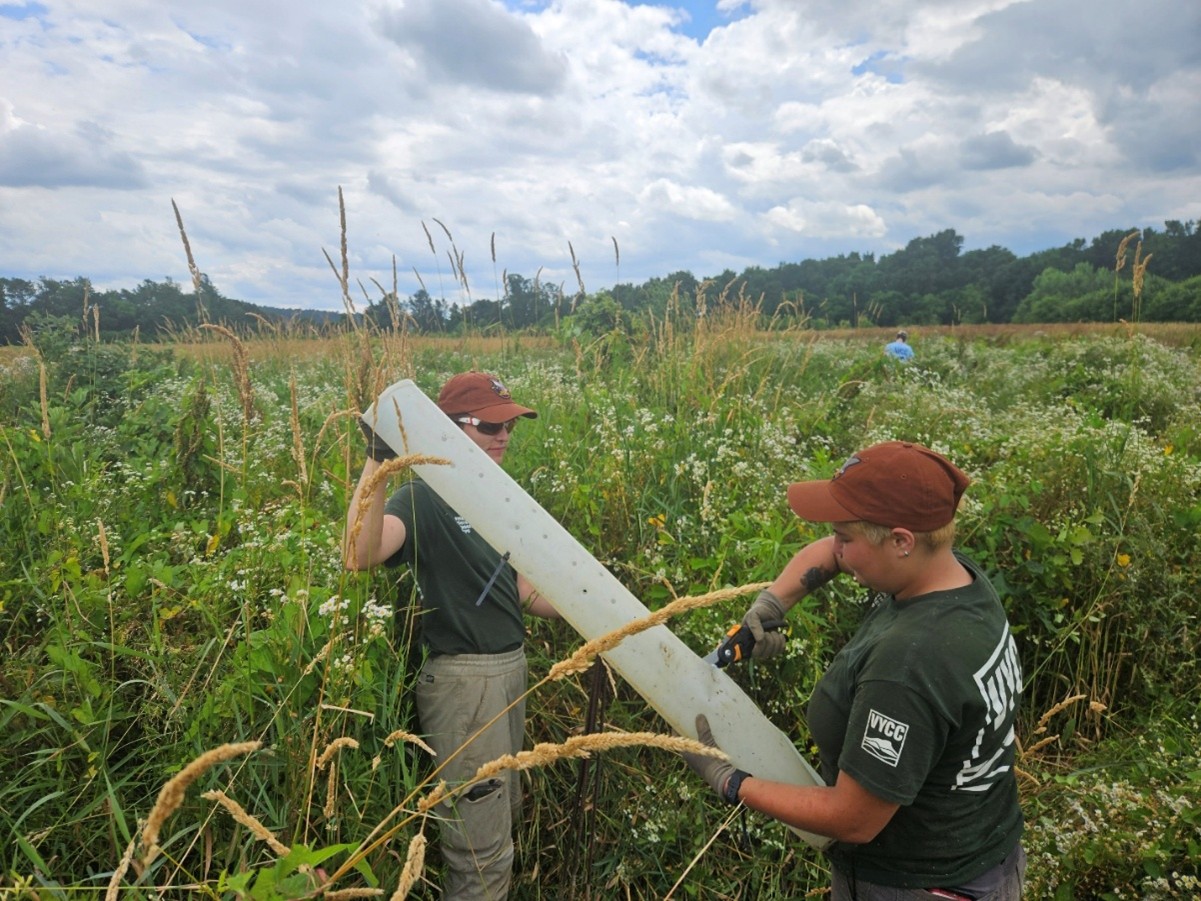In-Lieu Fee Program Fuels Conservation at Three Mile Bridge WMA
Compensatory mitigation restores, enhances, and creates wetland habitat to offset unavoidable impacts from development and infrastructure projects
Compensatory mitigation restores, enhances, and creates wetland habitat to offset unavoidable impacts from development and infrastructure projects
On a gray and rainy October morning in 2024, a white 15-passenger van and box trailer with “VYCC” on the side pulled into a small parking area at the Ducks Unlimited (DU) Three Mile Bridge wetland restoration site. Out climbed a group of young adults in raincoats, knee-high boots, and Carhartt overalls. They were members of the Vermont Youth Conservation Corps (VYCC). The crew greeted DU restoration technician Winston Gedicks and DU program manager Mary Beth Poli.
Gedicks shared the day's objectives with the crew: planting live stakes of various wetland-loving trees and shrub species. The group gathered their supplies into plastic sleds (mallets and loppers from the box trailer and hundreds of bundles of live stakes) to be pulled into the wetland.
Live stakes are made from cutting branch sections from a living tree or shrub at the appropriate time of year. Willows are known to be highly successful when planted this way, but other species, like dogwoods, buttonbush, and even sycamores, also do well. Once hammered into the ground, these freshly cut branches sprout roots and leaves by spring, transforming bare ground into thickets that stabilize streambanks, slow floodwaters, and provide food and cover for ducks, songbirds, and pollinators.
This hands-on work is part of DU’s Compensatory Mitigation Services program. Compensatory mitigation means restoring, enhancing, or creating wetlands and other aquatic resources to offset unavoidable impacts from development or infrastructure projects. This ensures that new healthy wetlands are created or protected when negative impacts affect our natural resources.

The sun sets on an oxbow at Three Mile Bridge WMA
The Three Mile Bridge wetland restoration project was funded by DU’s In-Lieu Fee (ILF) program, a partnership between DU, the U.S. Army Corps of Engineers, the state of Vermont, U.S. Fish & Wildlife, and the U.S. Environmental Protection Agency. Construction projects that impact existing wetlands purchase credits from the ILF program to restore wetlands within the larger watershed.
Three Mile Bridge is on a 140-acre property that was once in agricultural production. However, due to its location where the Middlebury River flows into Otter Creek, much of the property experiences flooding when it rains. Before DU’s acquisition in 2016, the site was a mix of corn and hay fields. Man-made ditches carried flood water to Otter Creek. While these ditches allowed the property to be farmed, production was marginal, and the wetlands on the property were degraded.
Once DU completed planning and design, restoration construction began in 2018. Contractors installed ditch plugs and reestablished oxbows in the former farm fields. Between 2019 and 2024, DU, Williams Forestry, Intervale Restoration Nursery, Redstart, and the VYCC planted over 30,000 trees, shrubs, and live stakes on about 60 acres. This system of shallow-water wetlands now supports waterfowl nesting and provides refuge during migration. In contrast, the oxbows provide added flood storage, mitigating downstream flood risk for nearby Middlebury and protecting buildings downtown where Otter Creek flows. The restored wetlands improve overall water quality by filtering sediments and nutrients.
The transformation has been dramatic. Wood ducks and green-winged teal have been observed in the restored wetlands, bobolinks sing from the grasslands, and bald eagles soar overhead. Beavers, turtles, and frogs thrive in the slow-moving waters, and native plants – from swamp white oaks to fox sedges – are now the dominant vegetation at the site. However, stewardship of these wetlands is a continuous process. DU biologists and partners have monitored vegetation and hydrology since 2021, adapting management strategies as needed. Additional tree plantings and invasive species control are scheduled through 2028, when the final performance goals are expected to be met.

VYCC volunteers removing tree tubes.
DU continued its partnership with the VYCC in July 2025, hiring them to remove tree tubes from swamp white oaks, American sycamores, and other trees that have grown tall enough to survive deer browse. Gedicks led the crew again with help from DU Regional Biologist Jess Eller. After a long workday, the VYCC crew camped at the local Green Mountain National Forest Moosalamoo campground. DU and VYCC staff debriefed their day while painstakingly picking thousands of beggarticks, velcroed to every inch of their clothing. Despite the nuisance, this shows a great sign of restoration success as Devil’s beggarticks are a native and beneficial plant in Vermont wetlands and provide excellent forage for waterfowl.
DU donated the property to the State of Vermont Fish & Wildlife Department in October 2020. It is now the Three Mile Bridge Wildlife Management Area, protected from development and open to the public year-round. DU occasionally hosts open houses so visitors can see the restoration work up close.
Spring and fall are some of the best times to visit—when frogs chorus near the oxbows, migrating ducks rest on the water, and Vermont’s foliage frames the wetland in brilliant color.
Ducks Unlimited uses cookies to enhance your browsing experience, optimize site functionality, analyze traffic, and deliver personalized advertising through third parties. By continuing to use this site, you agree to our use of cookies. View Privacy Policy